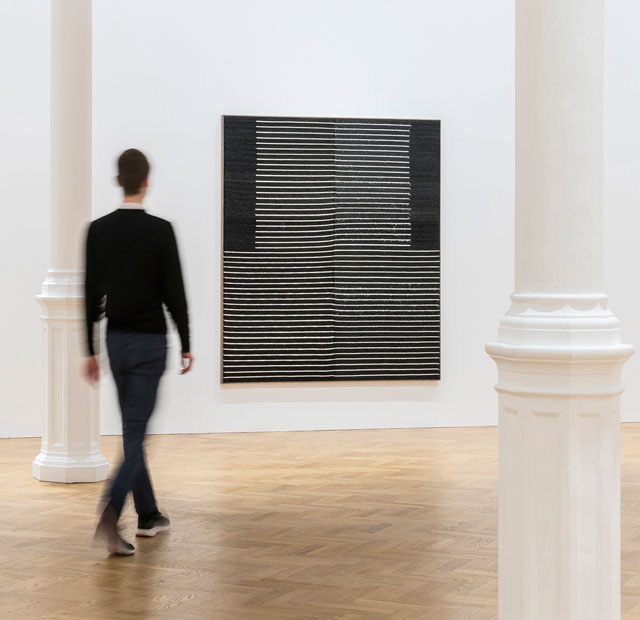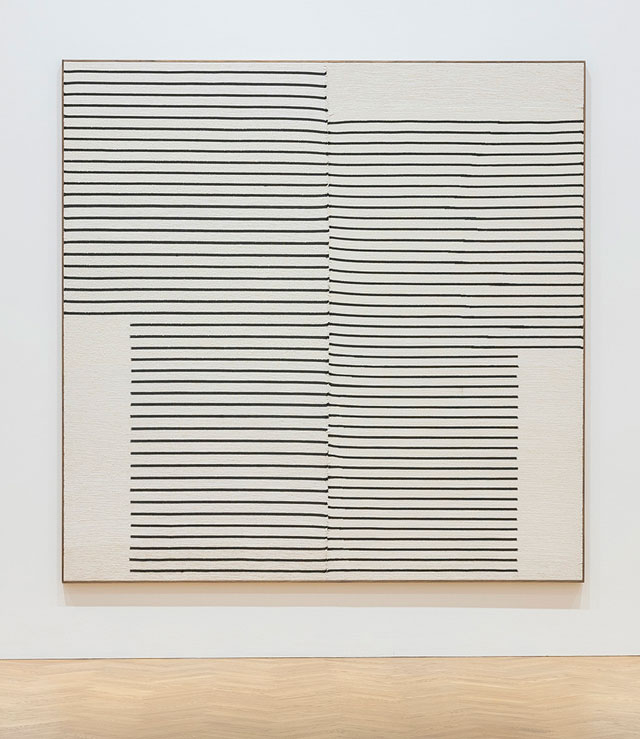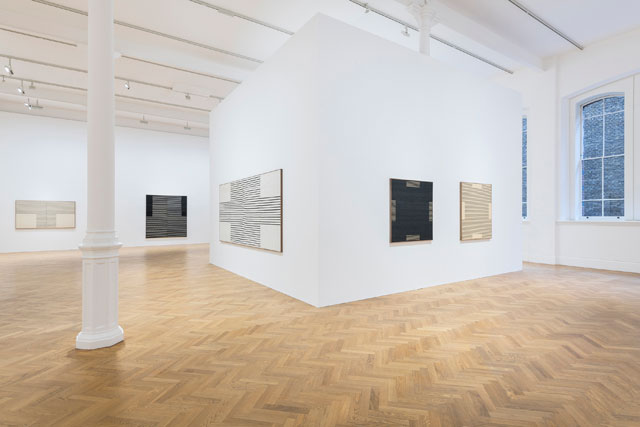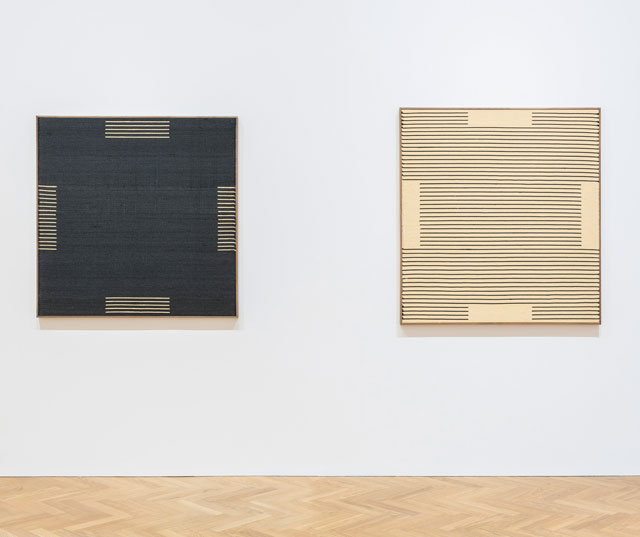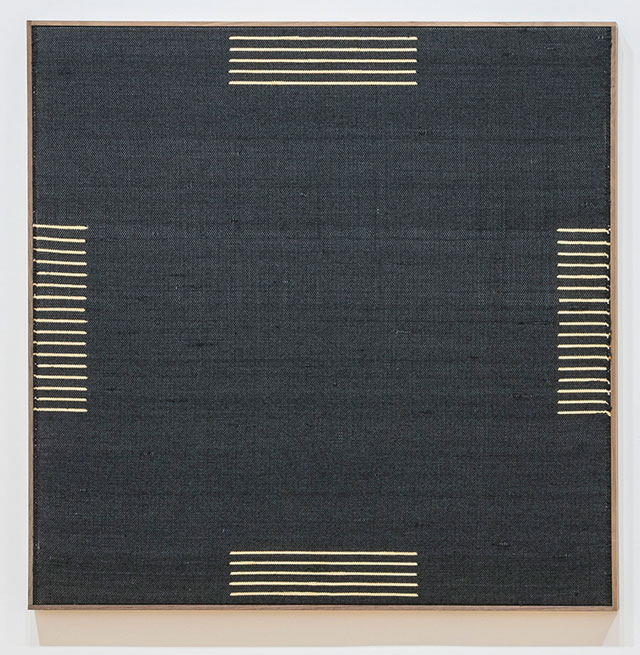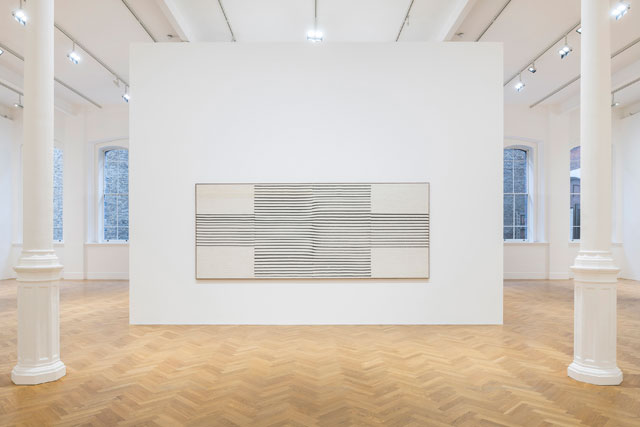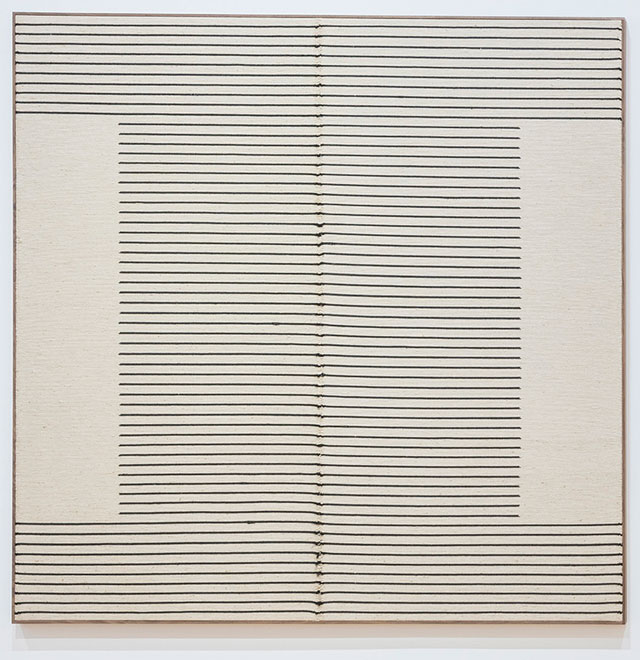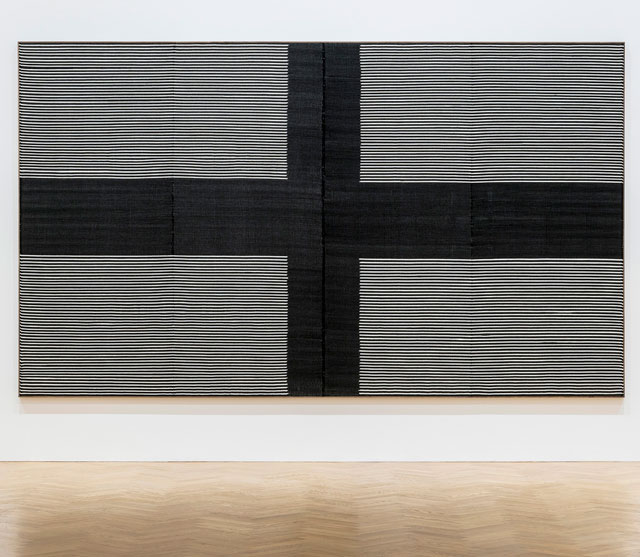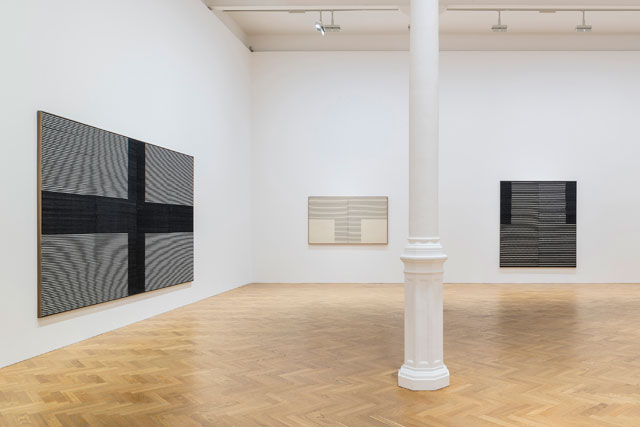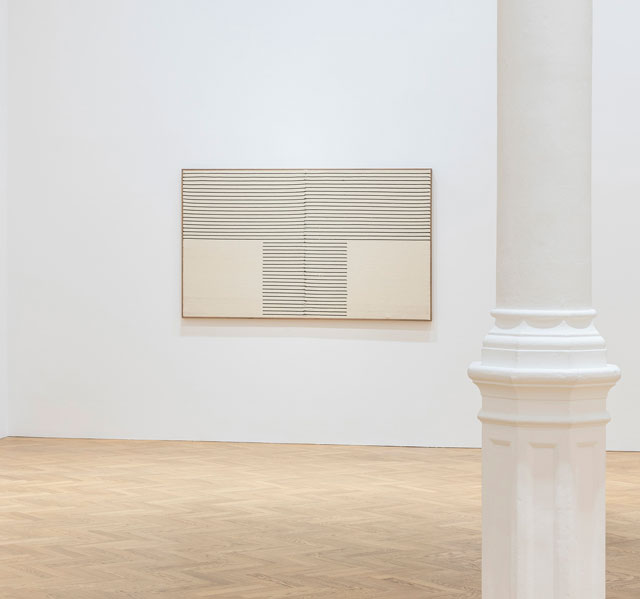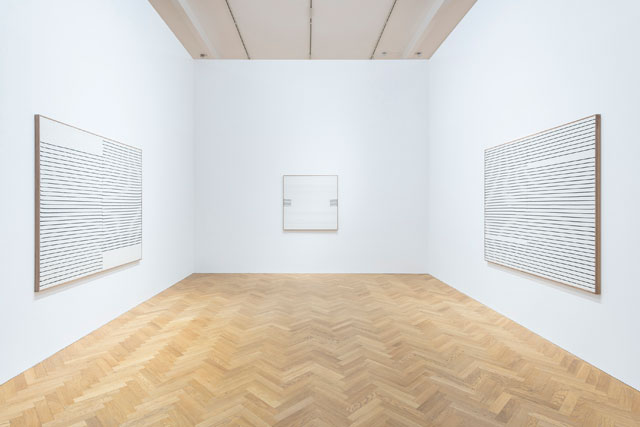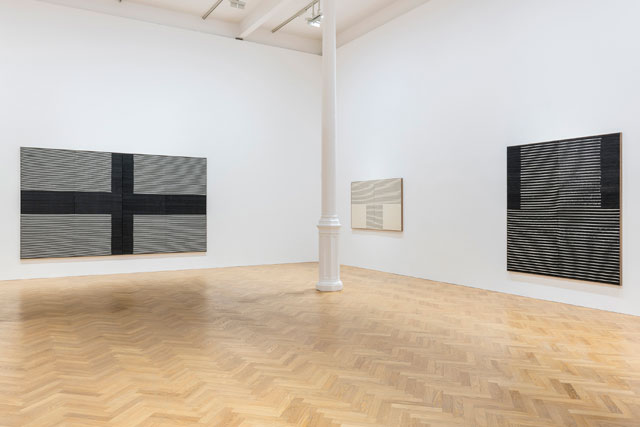

by IMOGEN GREENHALGH
Brent Wadden (b1979, Nova Scotia) is a Canadian artist who produces large-scale weavings that amount to an ongoing, self-directed experiment. Originally a painter, when Wadden began to work on the loom, he opted to teach himself, learning through trial and error. Now showing at the Pace Gallery in London, Sympathetic Resonance presents his latest compositions – a series of black-and-white geometric abstractions that explore the relationship between line and space. Although Wadden refers to them as “paintings” (as he does all his weavings), they are resolutely textile works, their surfaces fuzzy and speckled with slubs and stray threads. The minimalist woven grid repeatedly breaks down, giving way to glitches and digressions. Numerous works in the show comprise two panels that at first glance appear near identical, a stitched seam running down their middle like a faultline, disrupting the run of latitudinal stripes. Only up close do their differences materialise: symmetry suggested, and then subtly subverted.
Imogen Greenhalgh: How did the works in the show come about?
Brent Wadden: In 2016, I exhibited a variety of striped works that were made over the course of a few years. At the time, I was still trying to figure out how to develop this new format. There were two specific weavings in that show which became a starting point for the current exhibition at Pace. Both have thin stripes of black and white that were meant to span the surface of two panels sewn together. By total mistake, they each ended up with half an extra stripe, but only on one of the panels. Like most of the happy accidents, I just went with it. It was the empty space that was the crucial element to the success of the work – it’s something I have since expanded on.
[image3]
IG: So, chance takes on a formal role. I wondered if you could talk a little more about accidents in your work. You have often used the word mistake. What is it about the logic of the loom that has made the idea of the mistake so inviting? Has it always been a part of your practice?
BW: I love a good happy accident … And all the other accidents are fine, too. There is no way to erase a mistake when weaving unless you want to unweave a work – something I rarely do. All the individual mistakes end up being integral to each piece. Weaving is complex and there are so many different stages of production that it’s inevitable something goes wrong. I’ve got pretty good at accepting these moments and moving on. One thing is that the more proficient I become with weaving, the fewer mistakes I make. I think this is fairly obvious if you look at works from five or six years ago. My progress has allowed me to focus more on the compositional aspects of the work. Mistakes, while they still occur, happen more or less during the final stages.
[image2]
IG: How clear an image do you have in your mind when you start out?
BW: I usually come up with a basic concept for my next weaving while still working on the previous piece. Since it can take a few weeks to produce larger works, it gives me lots of time to think about what to do next. I typically begin with a small drawing, which I use as a guide, but I can never tell how it’s going to look in the end, especially with larger multi-panel works. I try to anticipate how things will line up, but it’s really the stretching of the final piece when things come together.
IG: You have experimented in the past with vivid colour, but in this show, focused on opposites: black and white. Was that the idea from the outset? What does working without a spectrum of colour clarify for you?
BW: I tend to move back and forth between using colour and not. When I was planning this body of work, I knew from the start that it was going to be primarily black and white, as I wanted to focus attention on the forms and the variations in each work.
[image11]
IG: Where did your interest in textiles, and working with fibre, come from? For many prominent artists, such as Sheila Hicks, an encounter with pre-Columbian art was the ignition, but since she was starting out, textiles and fibre art have become prevalent in the art world.
BW: I actually learned to sew at a young age as my mom was always knitting, sewing and cross-stitching around me. Because of my early interest and how normal it seemed, I never really considered the gendered implications of working in textiles. When I was older, a lot of my paintings and drawings contained intense patterns and bright colours. Friends would often comment on them, saying that they would translate over to textiles really well. These comments were flattering, and though I shied away for a long time, a seed was planted. In 2009, I contacted Travis Meinolf, an artist and weaver, who was living in Berlin at the time. He graciously loaned me a very tiny laser-cut backstrap loom that I worked on for a year, and each year I expanded the size and scale until I arrived at where I am now.
[image5]
IG: I wondered also about specific artistic influences. I think Anni Albers will be at the forefront of many visitors’ minds, given the major show on at the Tate Modern. How consciously do you engage with artists such as Albers, as well as painters such as Agnes Martin, whose book is presented next to your own at the gallery’s entrance? What, if anything, have you learned through looking at their work?
BW: I try not to let too many outside influences affect what I’m doing in the studio. This is just the way I operate, but it doesn’t take away from the fact that I have a huge amount of respect for Anni Albers, Agnes Martin and Sheila Hicks. I own numerous books by all three artists, but I do feel we have distinct paths. One funny story is that I had been weaving steadily for a few years before I realised that I had a Bauhaus weaving book sitting on the shelf next to where I work. It was a gift from someone, but, somehow, I had never opened it. Maybe it was impacting me on some subconscious level.
[image6]
IG: Another major reference point that you have mentioned is the generations of women quilters of Gee’s Bend in Alabama. Where did you first encounter their work?
BW: I think I first heard about Gee’s Bend around 2007 … perhaps through Tumblr? I loved how they worked outside the confines of what you normally see in traditional quiltmaking. There was a freedom in their crazy compositions and vivid colours. I also thought it was wonderful how they used found and recycled materials to create these most beautiful blankets. Around the same time, I became obsessed with Moroccan rugs – Beni Ourain, Azilal, but especially Boucherouite rugs, the last of which are constructed from scraps of T-shirt material and don’t appear to follow any set pattern. I appreciate how they break free from the rigid gridding typically seen in weaving.
IG: Let’s move on to the materials you use. You collect secondhand fibres, found on places such as Craigslist. Can you tell me how this works?
BW: For many years it has been a daily practice of mine to search through various websites, such as Craigslist, eBay, and Kijiji, looking for secondhand yarns. I recently scored a huge amount of materials and I don’t even have the room to store it all in my studio. So, I’m good for at least a year now. I also use a specific warp thread that I buy new.
[image7]
IG: How does the human, secondhand quality change the yarns when you are working with them?
BW: I like working within the limitations of whatever random materials I have on hand – there is no other way for me to create. At times, I need to buy new materials, such as black yarn for instance, as there is very little used black yarn out there. Since it’s something I use a lot, I always have a bin of new blacks that I combine with found yarns so it doesn’t look too clean. My inventory is constantly changing and once I use something up, that’s it … I will never find the same kind of yarn again. It definitely gives each work a special kind of energy. I try to not get overly nostalgic about where the materials came from, but, of course, it gets partially transferred into the works. If I was to only use new materials, the weavings would have a totally different feel.
[image8]
IG: When I saw the show, I kept thinking about definitions. You refer to your works as paintings, but, at the same time, they draw attention to their textile qualities. What does the word painting afford that, say, weaving wouldn’t? Is there a tension between the two, or is it a prompt for the viewer?
BW: This is something that comes up frequently when I’m discussing my work and I believe what it boils down to is intention. I studied painting and therefore feel I’m working within that learned language; I think in the same way as when I am painting.
I say this jokingly, but for a few years I was in denial that I was a “real”, weaver mostly because I’m self-taught and know what I’m making – at least from a traditional weaver’s perspective – is a bit shoddy. I never intended to learn all the techniques and terminology of the loom, and still don’t understand how to read patterns. It’s just not useful for what I’m trying to do.
[image9]
IG: You touched earlier on the notion of skill. You are upfront about being self-taught, and existing outside the realm of the trained weaver, but you have worked in this way for many years now. Can you say a little more about how your own dexterity has changed, and how that inflects what you make?
BW: I think one of the biggest changes has been spending far less time problem-solving. In the beginning, fairly basic issues would take me days to resolve. Looking back, I kind of regret that I didn’t take weaving classes. But, yes, the weavings have become more refined over time, with cleaner edges and tighter transitions between colours. This was bound to happen, as I have become more and more comfortable working with the medium. I have also developed some self-imposed standards, such as using the same kind of warp thread for every work, and making chains that are always the exact same length. And, finally, I have all three floor looms set to the widest they can weave.
[image10]
IG: On the subject of working at scale, there is the related question of time and endurance – not unique to the artist working on the loom, but certainly relevant. Does a piece ever exhaust or overwhelm you? Can that be productive?
BW: I personally need to keep busy in order to stay sane. The speed at which I can produce has been beneficial to my studio practice in many ways, as it forces me to put thought into what I’m making, and gives me ample time to decide on what to do next. Admittedly, it can be hard on my body at times, so I try to take time out to stretch and make an effort to take it easy when I need to. A few years ago I ended up with tennis elbow – a form of repetitive strain injury – and I couldn’t work for a few months. Luckily, this injury happened right before my son was born, so I was happy to take a few months off from weaving. I can still feel it from time to time, but know to stop well before it becomes an issue.
• Brent Wadden: Sympathetic Resonance is at Pace Gallery, London, until 10 January 2019.
